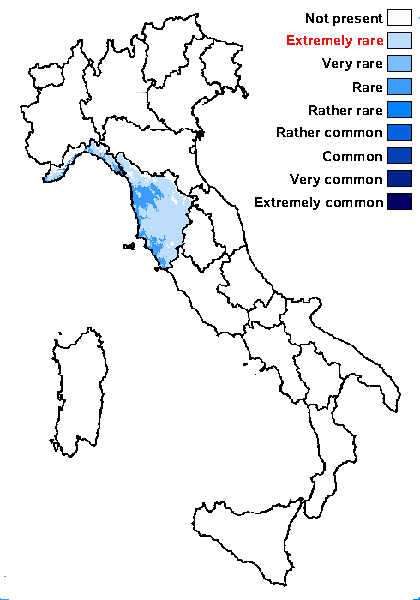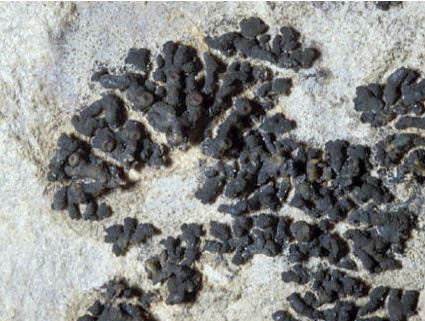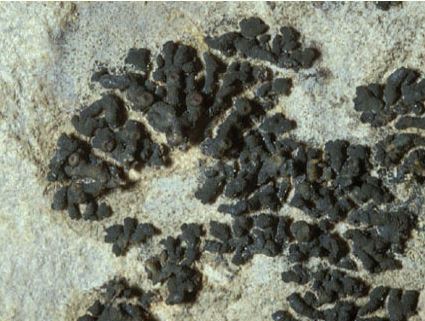Scytinium leptogioides (Anzi) Otálora, P.M. Jørg. & Wedin
Fungal Divers., 64, 1: 290, 2013. Basionym: Collema leptogioides Anzi - Comm. Soc. Critt. Ital., 1, 3: 132, 1862.
Synonyms: Leptogium marcii Harm.
Distribution: N - Lig. C - Tosc.
Description: Thallus subcrustose-placodioid to minutely foliose, subgelatinous when wet, dark green to green-black, forming orbicular , up to 1 cm wide rosettes, the central parts often falling off in old specimens. Lobes linear or (usually) broader towards apices, flat to slightly convex, 80-215 μm thick when wet, radiating, contiguous, smooth, 0.2-0.5 mm wide, with entire margins and rounded apices, densely and finely pubescent on upper surface, especially on lobe-tips. Lower surface paler, attached by sparse whitish hapters. Pseudocortex usually present on both surfaces, of a single layer of isodiametrical, angular cells. Apothecia lecanorine, sessile, 0.1-0.5 mm across, with a brown, concave to flat disc, and a thin, smooth, finally often excluded thalline margin. Thalline exciple usually pseudocorticate; proper exciple subparaplectenchymatous; epithecium brownish; hymenium colourless, 110-150 µm high; paraphyses mostly simple, 1.5-2 μm thick at mid-level, the apical cells slightly swollen; hypothecium colourless. Asci 8-spored, narrowly clavate, the apex strongly thickened, the apical dome K/I+ pale blue, with a downwardly projecting K/I+ deep blue tubular structure. Ascospores submuriform to eumuriform, with 3-4(-5) transverse septa and 1-2(-3) longitudinal septa, hyaline, ellipsoid with acute ends, 15-28(-30) x 8.5-10(-12) μm. Pycnidia superficial or immersed, globose, pale with dark apex. Conidia bacilliform, slightly swollen at both ends, 4-6 x 1.5-2 μm. Photobiont cyanobacterial (Nostoc, the cells in short chains). Spot test: all negative. Chemistry: without lichen substances. Note: a mainly Mediterranean species found on steeply inclined surfaces of calcareous rocks, often on cyanobacterial colonies, sometimes also on walls; to be looked for in Southern Italy.
Growth form: Foliose, narrow lobed
Substrata: rocks
Photobiont: cyanobacteria, filamentous (e.g. Nostoc, Scytonema)
Reproductive strategy: mainly sexual
On otherwise dry surfaces with short periods of water seepage after rain
Commonnes-rarity: (info)
Alpine belt: absent
Subalpine belt: absent
Oromediterranean belt: absent
Montane belt: absent
Submediterranean belt: absent
Padanian area: absent
Humid submediterranean belt: extremely rare
Humid mediterranean belt: rare
Dry mediterranean belt: absent

Predictive model
Growth form: Foliose, narrow lobed
Substrata: rocks
Photobiont: cyanobacteria, filamentous (e.g. Nostoc, Scytonema)
Reproductive strategy: mainly sexual
On otherwise dry surfaces with short periods of water seepage after rain
Commonnes-rarity: (info)
Alpine belt: absent
Subalpine belt: absent
Oromediterranean belt: absent
Montane belt: absent
Submediterranean belt: absent
Padanian area: absent
Humid submediterranean belt: extremely rare
Humid mediterranean belt: rare
Dry mediterranean belt: absent

Predictive model
 Index Fungorum
Index Fungorum
 GBIF
GBIF



